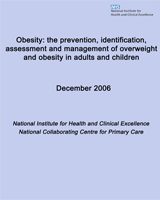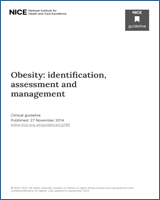NCBI Bookshelf. A service of the National Library of Medicine, National Institutes of Health.
Centre for Public Health Excellence at NICE (UK); National Collaborating Centre for Primary Care (UK). Obesity: The Prevention, Identification, Assessment and Management of Overweight and Obesity in Adults and Children [Internet]. London: National Institute for Health and Clinical Excellence (UK); 2006 Dec. (NICE Clinical Guidelines, No. 43.)
This publication is provided for historical reference only and the information may be out of date.

Obesity: The Prevention, Identification, Assessment and Management of Overweight and Obesity in Adults and Children [Internet].
Show detailsThere is increasing recognition both in the UK and worldwide that there is an “obesity epidemic”. This is supported by research evidence based on analyses of national surveys going back over twenty years. The issue has received much attention recently from politicians, professionals, the media and the public. Changes in lifestyle, work and leisure probably all contribute to the present situation. Estimates suggest that more than 12 million adults and 1 million children in England will be obese by 2010 if no action is taken. Currently most action has been at the individual level, with programmes of diet and exercise, and while these may have some benefit, they have made little impact on halting the rise of obesity at a national level. With so many publications and claims, and with the awareness that often success for the individual is short lived, many find it difficult to know what action is appropriate in the prevention and treatment of obesity. There is significant variation in existing service provision and, in many places, the multicomponent programmes that are required for both prevention and treatment are limited.
This full guidance and the related publications seek to produce the first comprehensive and integrated approach to prevention, maintenance and treatment. It is generally accepted that obesity is one of the major challenges to public health at this time and I hope that these publications will contribute to both informed debate and action.
While as in many areas of public health and health care the evidence is limited, we believe that the initial separate searching of the published papers on public health and clinical care, which yielded a consistency of approach, has helped to strengthen our recommendations. However we are very clear in our recommendations that there is urgent need for well designed, longer term studies with agreed outcomes carried out in normal settings in this country to provide better evidence as to what works in both prevention and treatment.
In producing the recommendations there is always a dilemma between being very prescriptive and being rather general. We have sought to be sufficiently flexible to take account of the diversity of personal life style and circumstances and to ensure that in treatment, there is recognition of clinical judgement, as well as the necessity of an agreed approach by the individual and family.
Our recommendations have been formulated with different audiences in mind: public; professionals and those in responsible positions in the health services, local government, education, partnership organisations, the workplace and the voluntary sector. Just as there is no single or simple approach that will be effective in the treatment of overweight or obesity so, a broad and comprehensive approach is required for wider public health action.
I am most grateful to all those who have contributed positively to the preparation of this guidance during the past 18 months. It has been a pleasure to work with them and it is our hope that these recommendations will provide clear and practical help. In addition to the usual skills of a range of health professionals, those involved in clinical care, and patients, we have had the advice of those in local government, voluntary and community organisations, sports and exercise and the workplace. In this guidance, for the first time, NICE Recommendations are not exclusively aimed at those in the health service.
While obesity is recognised as a priority, there are of course competing priorities, although some of these, such as diabetes and heart disease, are closely linked. However few other problems are causing such widespread concern over their increase and their impact on health and quality of life.
We have sought to produce guidance that will build on the existing services, recognising that further training and staff will be required. The report aims to be ambitious and forward looking. To do otherwise would have been irresponsible with a major health priority, which is continuing to increase in prevalence.
Professor Jim McEwen, Chair of the Guidance Development Groups
Clinical guidance
The last ten years have seen increasing recognition of the importance of obesity in the UK adult population and its association with a range of significant health problems, including type 2 diabetes. There has also been increasing concern about the rise of childhood obesity and the implications of such obesity persisting into adulthood.
As a practising GP, I know that primary care has a crucial role to play in the assessment and management of adults with obesity. In order for primary care health workers to take on this role they need to know what works and require better training and resourcing of management programmes that incorporate dietary advice, physical activity and behavioural change (multicomponent interventions). This clinical guideline offers general practitioners, practice nurses, community dietitians and others a systematic review of the evidence of weight loss interventions, with clear summaries of their effectiveness.
What is striking is that we lack good evidence of the effectiveness of a number of key interventions, particularly in children. But the recommendations themselves are clear and capable of implementation, with a clear message that management should be targeted at those with the highest potential to benefit from weight loss and that drugs should only be used to manage obesity when such multicomponent interventions have been delivered.
This guidance is a significant achievement on two counts. First, it provides integrated clinical and public health guidance on the prevention as well as the management of obesity and the overweight. It is well recognised that the epidemic of obesity cannot simply be addressed through behavioural change at individual level; population based interventions are needed to change the “obesogenic environment” of modern industrialised nations. Second, it is the result of a three year collaboration between the National Collaborating Centre for Primary Care, hosted by the Royal College of General Practitioners, who led on the clinical part of the guidance and the Centre for Public Health Excellence at NICE, who led on the public health aspects of the guidance. The use of two guidance development subgroups (clinical and prevention), chaired by an experienced public health physician, offers a successful model for developing further integrated primary care/public health guidance for the NHS and other bodies in the future.
We must take every necessary step to tackle obesity. This publication is an important step in that effort and I commend it to clinicians and commissioners.
Professor Mayur Lakhani FRCGP,
Chairman, Royal College of General Practitioners
- Foreword - Obesity: The Prevention, Identification, Assessment and Management of...Foreword - Obesity: The Prevention, Identification, Assessment and Management of Overweight and Obesity in Adults and Children
- PREDICTED: Homo sapiens dishevelled associated activator of morphogenesis 2 (DAA...PREDICTED: Homo sapiens dishevelled associated activator of morphogenesis 2 (DAAM2), transcript variant X12, mRNAgi|2462607472|ref|XM_054354959.1|Nucleotide
- disheveled-associated activator of morphogenesis 2 isoform X5 [Homo sapiens]disheveled-associated activator of morphogenesis 2 isoform X5 [Homo sapiens]gi|2462607457|ref|XP_054210926.1|Protein
Your browsing activity is empty.
Activity recording is turned off.
See more...
